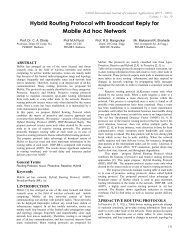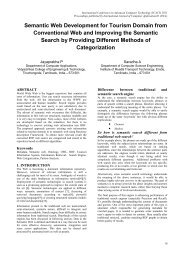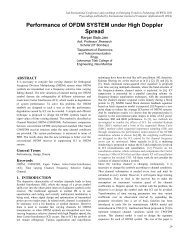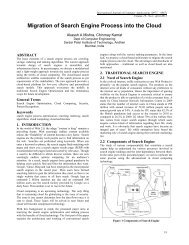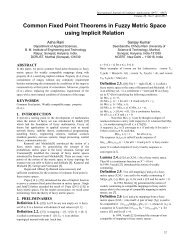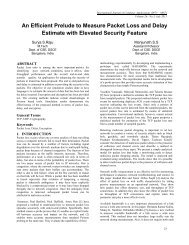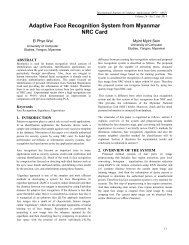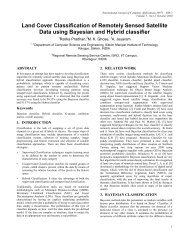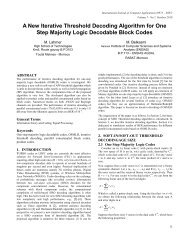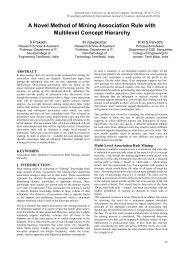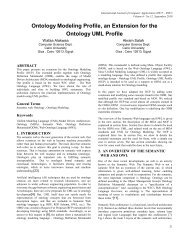Optimal Coordination of Directional Overcurrent Relays using ...
Optimal Coordination of Directional Overcurrent Relays using ...
Optimal Coordination of Directional Overcurrent Relays using ...
Create successful ePaper yourself
Turn your PDF publications into a flip-book with our unique Google optimized e-Paper software.
International Journal <strong>of</strong> Computer Applications (0975 – 8887)<br />
Volume 10– No.2, November 2010<br />
In this paper, the problem <strong>of</strong> coordinating directional over<br />
current relays in power systems is stated and solved in the<br />
framework <strong>of</strong> optimization theory. The proposed approach<br />
determines the "optimal" solution to this coordination problem in a<br />
cost effective and efficient way, by stating the problem as a<br />
parameter optimization problem, and solving it <strong>using</strong> efficient<br />
optimization techniques. Here the optimization <strong>of</strong> Time Dial<br />
Setting and minimized function got from Linear programming<br />
with Large-Scale: Interior Point in Matlab has been done by<br />
Particle swarm Optimization technique coded in C#. It is pertinent<br />
to mention here that the Optimization methodology presented in<br />
this paper can also be applied to the problem <strong>of</strong> optimal<br />
coordination <strong>of</strong> protective relays other than directional over<br />
current relays (e.g. distance relays [9]). The optimization approach<br />
and its particularization to the case <strong>of</strong> directional over current<br />
relays are presented below<br />
III. DOCR OPTIMAL COORDINATION PROBLEM<br />
DOCR coordination problem is a parametric optimization<br />
problem, where different constraints have to be considered in<br />
solving the objective function. Here the objective function to be<br />
minimized is the sum <strong>of</strong> the operating times <strong>of</strong> the relays<br />
connected to the system, subject to the following constraints.<br />
A. Relay Characteristics:<br />
A typical inverse time directional overcurrent relay has two<br />
units, an instantaneous unit(time independent) and an inverse<br />
overcurrent unit (time dependent). The time dependent unit has<br />
two values to be set, the pickup current (Ip) and the time dial<br />
setting (TDS). The pickup value is the minimum value <strong>of</strong> current<br />
for which the relay operates. The time dial setting defines the<br />
operating time (T) <strong>of</strong> the relay for each current value. The<br />
characteristics <strong>of</strong> the OCR are given as a curve <strong>of</strong> T versus M,<br />
where, i.e.<br />
M = I/I P (1)<br />
Where I is the relay current (overload/fault current). M is a<br />
multiple <strong>of</strong> the pickup current and I P is the pickup current.<br />
Here the overcurrent relay is conformed to the following IEC<br />
characteristic [6,10]. The following formula is used to<br />
approximately represent the inverse overcurrent relay<br />
characteristics.<br />
T = k 1 .TDS/ (M k2 -1) (2)<br />
Where k 1 and k 2 are constants that depend on the relay<br />
characteristics.<br />
The relation between the operating time (T) <strong>of</strong> the time<br />
overcurrent unit and the multiple <strong>of</strong> pickup current (M), is<br />
nonlinear. The multiple <strong>of</strong> pickup current <strong>of</strong> the relays can be<br />
predetermined and so for a fixed M, the above equation can be rewritten<br />
as<br />
T = a . TDS<br />
(3)<br />
Where<br />
a<br />
1<br />
=<br />
k2<br />
M<br />
K<br />
−1<br />
B. Relay Settings:<br />
The calculation <strong>of</strong> the two settings, TDS and Ip, is the essence<br />
<strong>of</strong> the directional <strong>Overcurrent</strong> relay coordination study. It is very<br />
important to mention that in general, directional overcurrent relays<br />
allow for continuous time dial settings but discrete (rather than<br />
continuous) pickup current settings.<br />
Therefore this constraint can be formulated as:<br />
TDS<br />
i<br />
≤ TDS<br />
i<br />
≤ TDS<br />
min i max<br />
I pi min ≤ I pi ≤ I pi max<br />
C. <strong>Coordination</strong> Formulation:<br />
In any power system, a primary protection has its own backup<br />
one for guaranteeing a dependable power system. The two<br />
protective systems (primary and back-up) should be coordinated<br />
together. <strong>Coordination</strong> time interval (CTI) is the criteria to be<br />
considered for coordination. It’s a predefined coordination time<br />
interval and it depends on the type <strong>of</strong> relays. For electromagnetic<br />
relays, CTI is <strong>of</strong> the order <strong>of</strong> 0.3 to 0.4 s, while for a<br />
microprocessor based relay, it is <strong>of</strong> the order <strong>of</strong> 0.1 to 0.2 s.<br />
To ensure reliability <strong>of</strong> the protective system, the back-up<br />
scheme shouldn’t come into action unless the primary (main) fails<br />
to take the appropriate action. Only when CTI is exceeded, backup<br />
relay should come into action.<br />
This case is expressed as<br />
T<br />
backup<br />
Where<br />
− T<br />
primary<br />
≥ CTI<br />
T<br />
backup<br />
is the operating time <strong>of</strong> the backup relay.<br />
T<br />
primary<br />
is the operating time <strong>of</strong> the primary relay.<br />
After considering all these criteria, this problem can be<br />
formulated mathematically as<br />
min<br />
n<br />
∑ i = 1<br />
a i<br />
. TDS<br />
Where i=1 to n, n represents the number <strong>of</strong> relays.<br />
i<br />
IV. ALOGRITHAM OF PSO<br />
PSO1: Initialize positions and associated velocity <strong>of</strong> all<br />
particles (potential solutions) in the population randomly in the D<br />
dimension space.<br />
PS02: Evaluate the fitness value <strong>of</strong> all particles.<br />
PS03: Compare the PBEST <strong>of</strong> every particle with its current<br />
fitness value. If the current fitness value is better, then assign the<br />
current fitness value to PBEST.<br />
PS04: Determine the current best fitness value in the whole<br />
population. If the current best fitness value is better than the<br />
GBEST, then assign the current best fitness value to GBEST .<br />
PS05: Change velocities <strong>using</strong> t8he following equation:<br />
V(t+1) id = w × vi(t) + c1 × rand() × (pbestid − S(t)id ) + c2 ×<br />
Rand() × (gbestd – S(t)id) (4)<br />
Where<br />
i=1, 2---- n; d=1, 2--- m.<br />
‘n’ is the population size,<br />
‘m’ is the number <strong>of</strong> units and<br />
the ‘w’ value is set <strong>using</strong>:<br />
w = wmax – ((wmax – wmin) / itermax) × iter<br />
44



